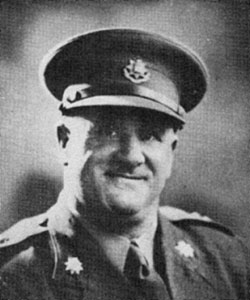Malaya
Japanese Invasion of the Island
Then on 8th February, the Japanese crossed the straits at several points and, supported by heavy shelling and dive-bombing attacks, invaded the north west coast of the Island. This vital area was held by the 8th Australian Infantry Division with 44 Indian Infantry Brigade. The enemy quickly established a bridgehead in the Australian sector, and by 0800 hours the next day were attacking Tengah airfield. By nightfall the airfield was in Japanese hands. Enemy landings in strength continued throughout the day.
 |
| Captain Gingell. |
An attempt was made to establish a stop-line facing westwards, running from the River Kranji in the north to the River Jurong in the south, a distance of about 4 ½ miles. The 6/15 Brigade was put under command of the 8th Australian Division and moved across to fill a gap between the 44th Indian Brigade and the 22nd Australian Brigade on the Tengah road. The British Battalion was moved by motor transport to the Racecourse, north west of the city. Soon after arrival they set off on a night march of 6 miles to their defensive positions around some brick works, arriving at 0400 hours on 10th February.
The enemy attacked the stop-line violently and at about 1030 hours it was found that the Australians on the right had withdrawn; then the Indian Battalion on the Jurong road on the left pulled back. As the British Battalion had both flanks in the air, they were ordered to withdraw 3 miles to the east at 1345 hours, and to come into Brigade reserve. By this time armour and artillery were pouring across into the north west part of the Island, a substantial part of which was now in enemy hands. Although the British Battalion was not closely involved in this battle, there were a number of casualties, including Lieutenant Bobe killed.
A counter-attack by 11 Indian Division planned for 11th February proved a disastrous failure, the Japanese launching an attack on our left flank at the same time. At 0730 hours the enemy attacked once more. In the close quarter fighting that followed, RSM Meredith of the Leicesters led a bayonet charge which cleared the area and caused many enemy casualties. For this, and other fine work, the RSM was subsequently awarded the Distinguished Conduct Medal. The last days of the fighting are described by Private Ruoff at Annex J.
Owing to the thrust on the left flank there was a danger of the Battalion being surrounded, and Brigadier Coates ordered the Brigade to fight its way back to Bukit Timah, a couple of miles to the east. Major Wallis, who knew the area from the Surreys' first six months in Malaya, led the Brigade across country in a south easterly direction. During the withdrawal, which started at 0930 hours, they were attacked from both flanks, from the rear and from the air, and became considerably disorganised. Bukit Timah had fallen, and the Battalion was placed under command of 22nd Australian Brigade. For his leadership and personal courage on this and other occasions, Major Wallis was awarded the Military Cross.
The Regimental History of the Leicesters records that notwithstanding the confusion "Captain Gingell, the Quartermaster, ran the Battalion to earth and produced a hot meal. In spite of all the vicissitudes experienced by the British Battalion throughout the campaign, it very seldom, thanks to Captain Gingell, went without a hot meal".
During the afternoon the Battalion came under heavy artillery fire and sustained a number of casualties, including the gallant RSM Meredith who was wounded. Before dark Lieutenant Abbott arrived with a number of men who had become detached from the unit. The Battalion was now widely dispersed and very weak, so the Commanding Officer decided to reorganise into two companies, one Surreys and one Leicesters. That evening the Battalion was in Brigade reserve on the outskirts of Singapore town. Both Regimental Histories describe 11th February as 'a disastrous day'.
Related
